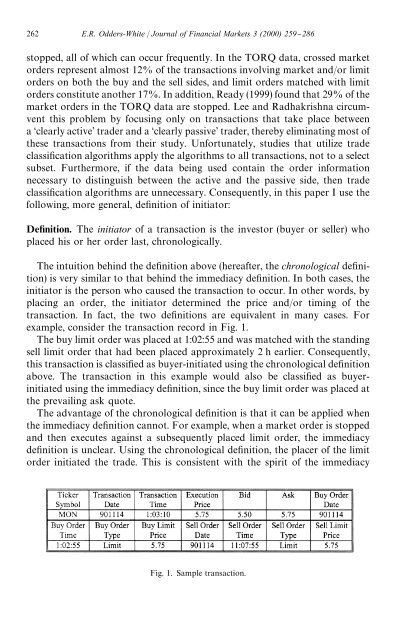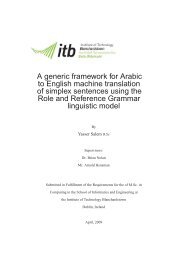On the occurrence and consequences of inaccurate ... - Acsu Buffalo
On the occurrence and consequences of inaccurate ... - Acsu Buffalo
On the occurrence and consequences of inaccurate ... - Acsu Buffalo
Create successful ePaper yourself
Turn your PDF publications into a flip-book with our unique Google optimized e-Paper software.
262 E.R. Odders-White / Journal <strong>of</strong> Financial Markets 3 (2000) 259}286<br />
stopped, all <strong>of</strong> which can occur frequently. In <strong>the</strong> TORQ data, crossed market<br />
orders represent almost 12% <strong>of</strong> <strong>the</strong> transactions involving market <strong>and</strong>/or limit<br />
orders on both <strong>the</strong> buy <strong>and</strong> <strong>the</strong> sell sides, <strong>and</strong> limit orders matched with limit<br />
orders constitute ano<strong>the</strong>r 17%. In addition, Ready (1999) found that 29% <strong>of</strong> <strong>the</strong><br />
market orders in <strong>the</strong> TORQ data are stopped. Lee <strong>and</strong> Radhakrishna circumvent<br />
this problem by focusing only on transactions that take place between<br />
a &clearly active' trader <strong>and</strong> a &clearly passive' trader, <strong>the</strong>reby eliminating most <strong>of</strong><br />
<strong>the</strong>se transactions from <strong>the</strong>ir study. Unfortunately, studies that utilize trade<br />
classi"cation algorithms apply <strong>the</strong> algorithms to all transactions, not to a select<br />
subset. Fur<strong>the</strong>rmore, if <strong>the</strong> data being used contain <strong>the</strong> order information<br />
necessary to distinguish between <strong>the</strong> active <strong>and</strong> <strong>the</strong> passive side, <strong>the</strong>n trade<br />
classi"cation algorithms are unnecessary. Consequently, in this paper I use <strong>the</strong><br />
following, more general, de"nition <strong>of</strong> initiator:<br />
De5nition. The initiator <strong>of</strong> a transaction is <strong>the</strong> investor (buyer or seller) who<br />
placed his or her order last, chronologically.<br />
The intuition behind <strong>the</strong> de"nition above (hereafter, <strong>the</strong> chronological de"nition)<br />
is very similar to that behind <strong>the</strong> immediacy de"nition. In both cases, <strong>the</strong><br />
initiator is <strong>the</strong> person who caused <strong>the</strong> transaction to occur. In o<strong>the</strong>r words, by<br />
placing an order, <strong>the</strong> initiator determined <strong>the</strong> price <strong>and</strong>/or timing <strong>of</strong> <strong>the</strong><br />
transaction. In fact, <strong>the</strong> two de"nitions are equivalent in many cases. For<br />
example, consider <strong>the</strong> transaction record in Fig. 1.<br />
The buy limit order was placed at 1:02:55 <strong>and</strong> was matched with <strong>the</strong> st<strong>and</strong>ing<br />
sell limit order that had been placed approximately 2 h earlier. Consequently,<br />
this transaction is classi"ed as buyer-initiated using <strong>the</strong> chronological de"nition<br />
above. The transaction in this example would also be classi"ed as buyerinitiated<br />
using <strong>the</strong> immediacy de"nition, since <strong>the</strong> buy limit order was placed at<br />
<strong>the</strong> prevailing ask quote.<br />
The advantage <strong>of</strong> <strong>the</strong> chronological de"nition is that it can be applied when<br />
<strong>the</strong> immediacy de"nition cannot. For example, when a market order is stopped<br />
<strong>and</strong> <strong>the</strong>n executes against a subsequently placed limit order, <strong>the</strong> immediacy<br />
de"nition is unclear. Using <strong>the</strong> chronological de"nition, <strong>the</strong> placer <strong>of</strong> <strong>the</strong> limit<br />
order initiated <strong>the</strong> trade. This is consistent with <strong>the</strong> spirit <strong>of</strong> <strong>the</strong> immediacy<br />
Fig. 1. Sample transaction.
















